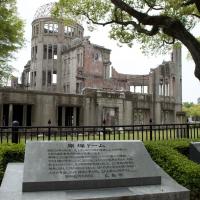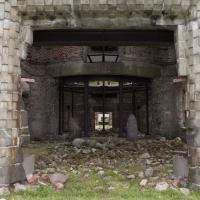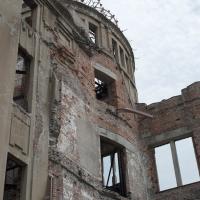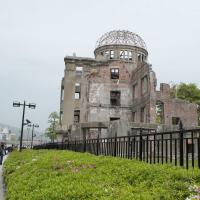Hiroshima Peace Memorial Park
Hiroshima Atomic Bomb Dome
The Atomic Bomb Dome (原爆ドーム) is one of the most famous monuments in Hiroshima Peace Memorial Park. It is a symbolic example and reminder of the devastation that Hiroshima City faced after the atomic bombing on August 6, 1945. The ruins of what was the Hiroshima Industrial Promotion Hall were named a UNESCO World Heritage Site in 1996.

History
The Atomic Bomb Dome was a famous attraction of the city even before its ruin and reemergence as a memorial. The large European-style three-story brick building was built by the prefecture to promote local products and businesses. Czech architect Jan Letzel (1880-1925) was commissioned to do the design in 1910 and it was completed in 1914. Parts of Jan Letzel's attractive design are still apparent today even in its current state.
Originally, the building was called the Hiroshima Prefectural Commercial Exhibition when it opened to the public in August of 1915. Its name was changed to the Hiroshima Prefectural Products Exhibition Hall in 1921 and later to the Hiroshima Prefectural Industrial Promotion Hall in 1933. The building not only used to sell local products but was used as an art gallery and exhibition hall for over 30 years.
On August 5, 1945, the atomic bomb exploded overhead (approximately 150 meters away). The intense downward force of the blast caved in its roof and crushed most of the building. Its sturdy construction, like many contemporary reinforced concrete buildings in Hiroshima City, allowed parts of the exterior walls to remain standing. The intense heat melted the copper roof and bent the supporting steel, but the five-story tall tower survived remarkably intact.
Symbol
After the bombing, the people of Hiroshima City couldn't decide whether to repair the building or to demolish it as was done with many other damaged buildings. Instead, it was left untouched as the controversial debate went on. At some point, people began referring to it as the Genbaku-Domu (Atomic Bomb Dome). In 1966, the city finally made the decision to preserve it as a monument for posterity.
Preserving the building has required extensive repair work to stabilize it. To date, there have been two major preservation efforts. After the decision in 1966, preservation work was urgently needed and 66 million yen was contributed world-wide to a preservation fund. By 1989, more repair work was needed as visible cracks were forming in the concrete and the 20 year old supports were rusting away. Over 395 million yen was raised for the preservation fund to repair the monument. The most visible part of this work are the internal beams that were added for support.
The skeletal building's iconic dome, still standing walls and rubble has become one of the most memorable images of the park and of Hiroshima City as a whole. Its status as a UNESCO World Heritage Site was granted in 1996 after a grass-roots campaign succeeded in having it recommended for this status by the Japanese government.
Getting There
The building is located in the northeast corner of Hiroshima Peace Memorial Park. The streetcar stop, Genbaku-Domu-Mae, is in front of the Atomic Bomb Dome.
From Hiroshima Station, the most convenient way to reach Hiroshima Peace Memorial Park is by street car. Get on a street car bound for Miyajima(#2) or Eba(#6). The stop for the park, Genbaku Dome-Mae, will be announced in English.
Hiroshima Peace Memorial Park is a 5 minute walk from the Hiroshima Bus Terminal in Sogo. Simply enter Shareo, the underground shopping mall, to cross the street and follow the signs.
Posted: April 5, 2011 Updated: February 23, 2015




